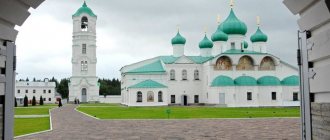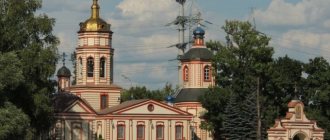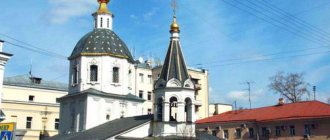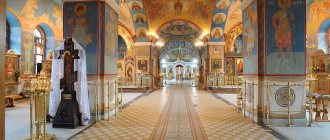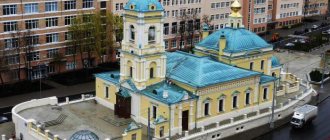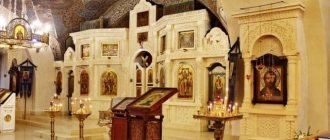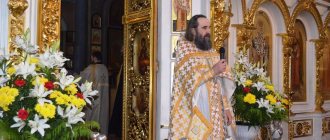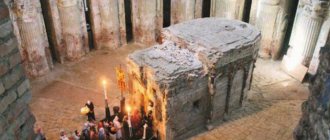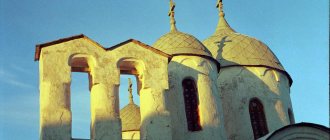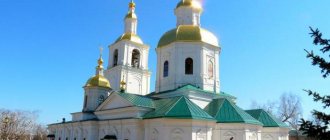Architecture and device
From its founding in the 17th century until 1938 (when it became patriarchal), the church was considered a parish church and belonged to the III deanery department. The first mention of the “newly built Church of the Epiphany in the village of Elokhov” is found in the decree of Patriarch Adrian of 1694.
Until 1717 (or 1722) the Epiphany Church was wooden and had a chapel in honor of the Annunciation. However, a little later, by order of Emperor Peter I, it was rebuilt in stone. The work was carried out with donations from Princess Praskovya Ivanovna, daughter of Tsar John V Alekseevich. In July 1731 (according to other sources - 1739) the temple was consecrated by Archbishop Leonid of Podonsk and Sarsk. At the end of the 18th century, the temple was completely rebuilt. Thus, in 1792, a new chapel in honor of St. Nicholas the Wonderworker was consecrated in the refectory; in 1793, the chapel in honor of the Annunciation was re-consecrated. In the middle of the 19th century, the temple was reconstructed once again. According to the design of the architect Evgraf Tyurin, in 1837–45, the cramped and dilapidated church building was rebuilt in such a way that only the refectory and the first tier of the bell tower retained their original appearance. After such a global reconstruction, a new consecration of the building took place, which was performed by Metropolitan of Moscow and Kolomna Filaret (Drozdov). Already at the very end of the 19th century, in 1889, according to the design of architect Pavel Zykov, a large faceted dome was erected over the refectory and stepped decorative walls on its side facades. According to its layout, the Epiphany Cathedral is cross-domed, in the Empire style. The building ends with a majestic five-domed structure. The height of the cathedral reaches 65 meters, and the bell tower is the same. The area of the temple together with the porch reaches 1164 square meters. m, and its maximum capacity is three thousand people. Until 1748, there was a cemetery at the Elokhovsky Church, but by decree of Empress Elizabeth Petrovna it was abolished: the graveyard was leveled, and tombstones were used as building material “as needed.”
The official website of the monastery will tell you how to get there
Unfortunately, from the entire magnificent monastery complex only the Epiphany Cathedral and several minor buildings have survived. That is why all church life is currently concentrated in it. In addition, the following are assigned to the temple:
- Church of St. Nicholas of Myra "Red Bell" Address: 109012 Moscow, Nikolsky lane, 9a, building 1
Telephone.
- Temple of the Holy Unmercenaries Cosmas and Damian - in Starye Panekh Patriarchal Metochion in Kitai-Gorod, Moscow
Address: 109012, Moscow, Staropansky lane, building 2 - 4. Phone: (495) 624–42–82. Email:
- Chapel of the Iveron Icon of the Mother of God at the Resurrection Gate Patriarchal Compound Address: Moscow, Resurrection Gate, 1a.
The parish is headed by Archpriest Gennady Nefedov. Serving: Archpriests Antony Malov and Andrey Privalov, Priests Georgy Kamenev, Nikolai Nefedov. The Temple of the Epiphany itself, the former Epiphany Monastery, is located in Moscow.
This is China Town itself, next to the Moscow Kremlin, between Ilyinka and Nikolskaya streets.
Address: Church of the Epiphany of the b.Bogoyavlensky Monastery 109012 Moscow, Bogoyavlensky Ave., 2/6, building 4.
Phone, email
Church of the Epiphany of the B. Epiphany Monastery Official website
The official website of the cathedral is open. Here you can find out detailed information about the history of the Epiphany Monastery in Moscow and the Church of the Epiphany, check contact details, as well as directions.
It should be noted that the temple is active, so there are no excursions here.
By leaving a comment, you accept the user agreement
Pre-revolutionary life of the cathedral
Among Muscovites, the Epiphany Cathedral has always had a reputation as a “people's cathedral”, because its main parishioners were workers, peasants, small traders and merchants, as well as townspeople. However, the most famous parishioner of the Yelokhovsky Church was the poet Alexander Sergeevich Pushkin. So, on June 8, 1799, under No. 73, a record of his baptism was made in the parish register. A hundred years later, in 1899, the anniversary of the poet’s birth was solemnly celebrated in the temple. Already in our time, in 1992, a memorial plaque with the date of Pushkin’s baptism was placed at the entrance to the cathedral building.
Epiphany Cathedral in 1882
The Yelokhovsky Church survived the Napoleonic invasion of 1812 relatively safely. And although its sacristy was looted by French soldiers, the building itself was not seriously damaged, and the decoration was preserved from the fire. Towards the end of the 19th century, extensive charitable activities were launched at the cathedral. Thus, on the initiative of parishioners Matveev and Kamynin, a brotherhood was founded at the church to help the poorest parishioners, as well as an almshouse for 10 women and a shelter for 15 boys. In November 1875, a fraternity school opened for 35 boys. The Shchapov family of merchants played a significant role in the charitable activities of the temple. For example, Vasily Ivanovich Shchapov, being the head of the temple, bequeathed to him capital in the amount of 26 thousand rubles, which at that time was a considerable amount.
The era of turmoil and persecution
Like most churches and monasteries in Russia, Elokhovsky Cathedral survived the difficult times of Soviet rule. Initially, in November 1918, the cathedral community registered with the Moscow Council of Workers and Red Army Deputies. After this, church life continued, even the holy Patriarch Tikhon served here several times. It would seem that there were no complaints from the new government. But soon, after the start of a campaign to confiscate church valuables in 1922, the situation changed. On April 24 of the same year, liturgical utensils weighing more than 50 pounds were confiscated from the cathedral. A few years later, in 1926, by decision of the commission of the Department of Public Education of the Moscow City Council, the building of the Epiphany Cathedral was classified as a monument of church architecture of the first category. Nevertheless, on March 1, 1930, the Moscow Regional Executive Committee closed it. Thanks to the courage and perseverance of the parishioners and clergy, who collected about five thousand signatures in defense of the cathedral, the Presidium of the All-Russian Central Executive Committee overturned the decision of the capital authorities. However, calm was still a long way off. In 1934-35, repeated attempts were made to convert the temple building for various civil needs: they wanted to turn the shrine into a cinema, a museum of rare books, they were going to close it again due to the construction of the metro... With God's help and through the prayers of believers, none of these plans came true .
Patriarch Sergius (1867–1944)
By 1933, the Yelokhovsky Cathedral acquired special significance for the entire Church - it was here that episcopal consecrations began to take place with the participation of the highest clergy of the Russian Orthodox Church. Moreover, after the destruction of the Epiphany Cathedral in Dorogomilovo in 1938, the department of high priests moved to Elohovo. The beginning of the Great Patriotic War was marked by a miracle that affected the entire subsequent history of the temple. Soviet authorities planned to close the cathedral on June 22 after Sunday services. However, after Metropolitan Sergius (Stragorodsky) read out his message here “to the Pastors and Flock of Christ’s Orthodox Church,” in which he called on believers to stand up for the defense of the Fatherland, the authorities abandoned their intention to close the cathedral and made no further similar attempts. Subsequently, a constant collection of funds for defense needs was organized here. In total, from July 1941 to July 1944, more than 800 thousand rubles were contributed to the collection fund by believers and clergy.
During the Time of Troubles, the Epiphany monastery became the center of battles in Kitay-gorod
Since the monastery was under the patronage of the Great Moscow Princes, in the 7th century it received ownership of several courtyards from Kolomenskoye. In 1568, Tsar Ivan the Terrible imprisoned St. Philip, Metropolitan of Moscow, in the monastery. He dared to condemn the oprichnina.
Sergei Miloradovich. Defense of the Trinity-Sergius Lavra. 1894 During the Time of Troubles, monasteries became centers of resistance to the Poles. The Moscow Epiphany Monastery became the center of battles with the interventionists in Kitai-Gorod
During the Time of Troubles, the monastery became the center of battles in China Town. That is why the Poles burned and destroyed it during their stay in Moscow. In total, in the first half of the 17th century, the Epiphany Monastery burned twice.
Tsar Mikhail Fedorovich built a new stone cathedral for the monastery. Other representatives of noble families of Russia also built the monastery.
Ivan the Terrible imprisoned St. Philip in the Moscow Epiphany Monastery.
The niece of Prince Yuri Buinosov-Rostovsky, Ksenia Repnina, donated a courtyard on Nikolskaya Street to the monastery. A gate and gatehouse church of the Nativity of John the Baptist were built on this site.
At the same time, the monastery complex was divided into two parts. The southern part received the cathedral church, the abbot's chambers and the brethren's cells, and the northern part housed utility rooms.
Monument to the Likhud brothers near the Epiphany Cathedral, 2009. Greek monks Ioannikis and Sophronius Likhud opened a school at the Moscow Epiphany Monastery
In 1685, monks Ioannikis and Sophronius Likhud, who arrived from Greece, opened the Epiphany School in the monastery. The school accepted not only the children of aristocrats, but also ordinary people. We studied there for 15 years.
Nowadays, a monument to the brothers has been unveiled on the territory of the monastery. The school became the basis for the creation of the Slavic-Greek-Latin Academy, and subsequently the Moscow Theological Academy.
Nowadays
In the 90s of the 20th century, the life of the Epiphany Cathedral gradually returned to normal. In 1991, it received cathedral status. From 1991 to 1999, live broadcasts of Christmas and Easter services led by Patriarch Alexy II were broadcast from the church. Here, on Maundy Thursday, the patriarch performs the rite of consecration of the world, cooked the day before in the Small Cathedral of the Donskoy Monastery.
Patriarch Alexy II (1929 -2008)
Today, at the Epiphany Cathedral there is a baptismal church in the name of St. Basil the Blessed with a baptistery (a room for performing the Sacrament of Baptism), a Sunday school with the study of church singing, and a sisterhood of mercy. The cathedral itself houses many Orthodox shrines, for example, such as a shrine with a particle of the Tree of the Life-giving Cross of the Lord, particles of the right hand of the Apostle Andrew the First-Called, the head of St. John Chrysostom, the revered image of the Mother of God “Joy of All Who Sorrow” and many others. Two patriarchs of the 20th century, Sergius and Alexy II, are also buried here.
Read more materials about the holiday of Epiphany in the section
Contacts[edit]
Address:
Tver region, Vyshnevolotsky district, Vyshny Volochek, st. Ostashkovskaya, 2
8 (8233) 6-39-32
How to get there:
By car you can get to Vyshny Volochyok from Moscow and St. Petersburg along the M10 or M11 highways (toll). The cathedral is located in the very center of the city.
A large number of long-distance trains traveling along the Oktyabrskaya Railway stop in Vyshny Volochek - from the Leningradsky station in Moscow, Moskovsky station in St. Petersburg, from Tver, Novgorod, etc. The schedule can be clarified in the relevant information services.
